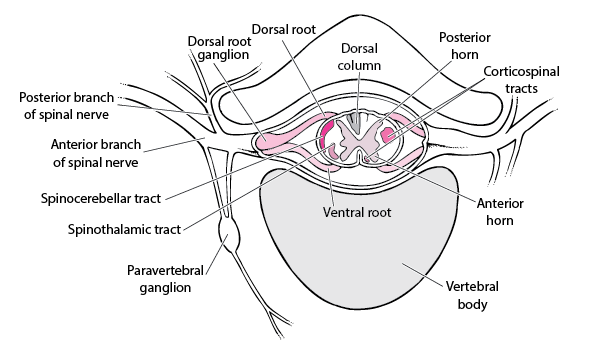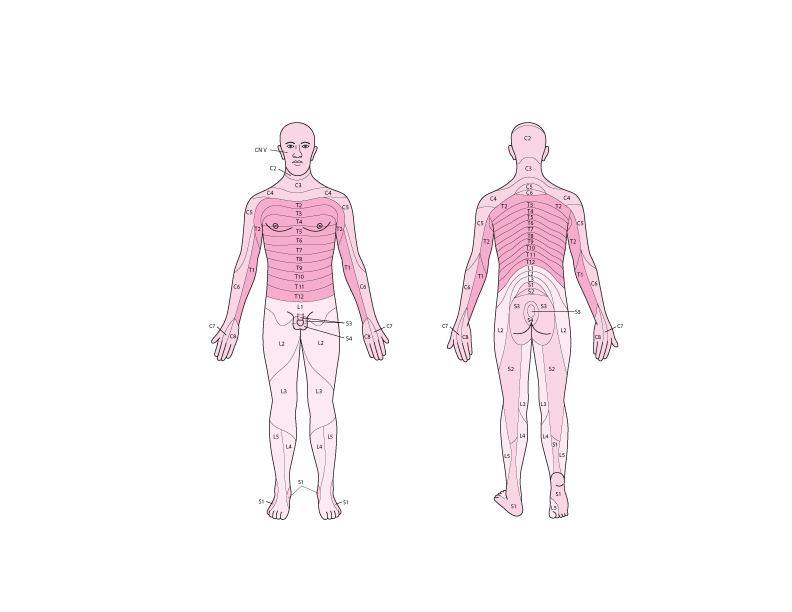“Numbness” can be used by patients to describe various symptoms, including loss of sensation, abnormal sensations, and weakness or paralysis. However, numbness is actually loss of sensation, either partial (hypesthesia) or complete (anesthesia).
Numbness may involve the three major sensory modalities to the same or different degrees:
Numbness is often accompanied by abnormal sensations of tingling (pins-and-needles) unrelated to a sensory stimulus (paresthesias). Other manifestations (eg, pain, extremity weakness, nonsensory cranial nerve dysfunction) may also be present depending on the cause.
Adverse effects of chronic numbness include
In addition, infections, diabetic foot ulcers, and injuries may not be recognized, leading to delayed treatment.
Sensory processing areas within the brain connect with cranial nerves or spinal cord sensory pathways. Sensory fibers exiting the spinal cord join just outside the cord to form dorsal nerve roots (except for C1—see figure Spinal nerve). These 30 dorsal sensory roots join with corresponding motor ventral roots to form spinal nerves. Branches of the cervical and lumbosacral spinal nerves join more distally to form plexuses and then branch into nerve trunks. The intercostal nerves do not form plexuses; these nerves correspond to their segment of origin in the spinal cord. The term peripheral nerve refers to the part of the nerve distal to the nerve root and plexus.
 |
Nerve roots from the most distal spinal cord segments descend within the spinal column below the end of the spinal cord, forming the cauda equina. The cauda equina supplies sensation to the legs, pubic, perineal, and sacral areas (saddle area).
The spinal cord is divided into functional segments (levels) that correspond approximately to the attachments of the pairs of spinal nerve roots. The area of skin supplied mostly by a particular spinal nerve is the dermatome corresponding to that spinal segment (see figure Sensory dermatomes ).
 |
Numbness can occur from dysfunction anywhere along the pathway from the sensory receptors up to and including the cerebral cortex. Common mechanisms include the following:
There are many causes of numbness. Although there is some overlap, dividing the causes based on the pattern of numbness can be helpful (see table Some Causes of Numbness).TABLESome Causes of Numbness

Because so many disorders can cause numbness, a sequential evaluation is done.
Although in practice certain elements of the history are typically asked selectively (eg, patients with a typical stroke syndrome are not usually asked at length about risk factors for polyneuropathy and vice versa), many of the potentially relevant components of the history are presented here for informational purposes.
History of present illness should include using an open-ended question to ask patients to describe numbness. Symptom onset, duration, and time course should be ascertained. Most important are
Possible precipitating causes (eg, compression of an extremity, trauma, recent intoxication, sleeping in an awkward position, symptoms of infection) are sought.
Review of systems should identify symptoms of causative disorders. Some examples are
Past medical history should identify known conditions that can cause numbness, particularly the following:
Family history should include information about any familial neurologic disorders. Drug and social history should include use of all drugs and substances and occupational exposures to toxins. For example, B6 (pyridoxine) supplements, when taken in excess, can cause a crippling loss of body sensations.
A complete neurologic examination is done, emphasizing the location and neurologic territories of deficits in reflex, motor, and sensory function. In general, reflex testing is the most objective examination, and sensory testing is the most subjective; often, the area of sensory loss cannot be precisely defined.
The following findings are of particular concern:
The anatomic pattern of symptoms suggests the location of the lesion but is often not specific. In general,
More specific localizing patterns include the following:
Findings that indicate involvement of multiple anatomic areas (eg, both brain and spinal cord lesions) suggest more than one lesion (eg, multiple sclerosis, metastatic tumors, multifocal degenerative brain or spinal cord disorders) or more than one causative disorder.
The rate of symptom onset helps suggest likely pathophysiology:
Degree of symmetry also provides clues.
After location of the lesion, rate of onset, and degree of symmetry have been determined, the list of potential specific diagnoses is much smaller, so that focusing on clinical features that differentiate among them is practical (see table Some Causes of Numbness). For example, if initial evaluation suggests an axonal polyneuropathy, subsequent evaluation focuses on features of each of the many possible drugs, toxins, and disorders that can cause these polyneuropathies.
Testing is required unless the diagnosis is clinically obvious and conservative treatment is elected (eg, in some cases of carpal tunnel syndrome, for a herniated disk or traumatic neuropraxia). Test selection is based on anatomic location of the suspected cause:
Electrodiagnostic tests can help differentiate between neuropathies and plexopathies (lesions distal to the nerve root) and more proximal lesions (eg, radiculopathies) and between types of polyneuropathies (eg, axonal and demyelinating, hereditary and acquired).
If clinical findings suggest a structural lesion of the brain or spinal cord or a radiculopathy, MRI is usually indicated. CT is usually a second choice but may be particularly helpful if MRI is not available soon enough (eg, in emergencies).
After the lesion is localized, subsequent testing can focus on specific disorders (eg, metabolic, infectious, toxic, autoimmune, or other systemic disorders). For example, if findings indicate a polyneuropathy, subsequent tests typically include complete blood count (CBC), electrolytes, renal function tests, rapid plasma reagin test, and measurement of fasting plasma glucose, hemoglobin A1C, vitamin B12, folate, thyroid-stimulating hormone, and usually serum immunoelectrophoresis and serum protein electrophoresis (particularly if the neuropathy is painful). Serum immunoelectrophoresis and serum protein electrophoresis can help diagnose multiple myeloma and multiple sclerosis.
Treatment is directed at the disorder causing numbness.
Patients with insensitive feet, particularly if circulation is impaired, should take precautions to prevent and recognize injury. Socks and well-fitting shoes are needed when walking, and shoes must be inspected for hidden foreign material before wear. The feet should be inspected frequently for ulcers and signs of infection. Patients with insensitive hands or fingers must be alert when handling potentially hot or sharp objects.
Patients with diffuse sensory loss or loss of position sense should be referred to a physical therapist for gait training. Precautions to prevent falls should be taken.
Driving skill should be monitored.